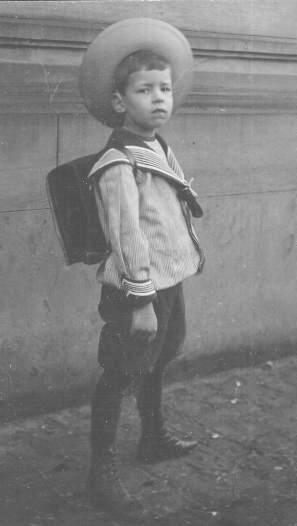
Figure 1.--Sailor suits were very popular schoolwear garments in the early 20th century. There were many different styles. This boy probably in the 1900s wears awide-brimmed sailor hat and sailor suit for school. |

|
We have very detailed information on the 20th century because of the abundance of available school pgotigraphs. German children did not wear school uniforms. Therefore they wore ordinarcy child and youth fashions. For many years children wore their better clothing to school, often dressing up. This varies somnewhat by academic level and chronolohical period. There was one exception here and this was the school cap. German boys wore a kind of peaked military cap to school. Not all boys wore them, but we note them both in primary and secondary schools. We are not sure when the German school cap first developed, but we note them being worn during the early 20th century. They continued to be worn in the 1930s, but not after World War II (1939-45). The sailor suit was very popular for German school children in the early 20th century. We also notice collar buttoning suits. Older boys might wear suits with lapels. Norfolk suits were quite popular. Many boys wore knee pants suits whic after World War I (1914-18) transitioned into short pants. Older boys might wear knickers or long pants. Boys wearing knee pants and short pants commonly wore long stockings, although this was somewhat seasonal. Gradually schoolwear became more casual. Sweaters began to replace suit coats. The trend toward casual wear became increasingly prevalent after World war II. Short pants were common, but gradully long pants became increasingly prevalent.
We note many German schoo children both in primary and secondary schools. We are not sure when the German school cap first developed, but we note them being worn during the early 20th century. The sailor suit was very popular for German school children in the early 20th century. Younger boys wore them with wide-brimmed sailor caps. We also notice collar buttoning suits. Older boys might wear suits with lapels. Norfolk suits were quite popular. Many boys wore knee pants suits.
The sailor suit continued to an enormously popular style for German school boys in the 1910s. Boys wore many different styles of sailor suits. Wide brimmed sailor hats were also worn, but caps were more popular.
Many boys wore the military styled school cap in the 1920s. Some primary school boys wore them, but they were most common in secindary schools. Sailor suits continued to be popular schoowear in the 1920s, but not nearly as popular as before World War I (1914-18). We see primary school children dressing more casually, wearing garments like sweaters. Boys attending secondary schools still generlly wore suits. Boys also continued wearing shortened-length pants. Knee pants transitioned into short pants. Older boys might wear knickers or long pants. Boys wearing knee pants and short pants commonly wore long stockings, although this was somewhat seasonal. This was most common for boys in promary school, but we also see younger teenagers in secondary school wearing long stockings. Black long stockings were prevalebnt in the early 20s, but we begin to see more lighter colors like light brown and grey by the end of the decade. Girls might wear white long stockings.
German boys continued wearing school caps in the 1930s. Gradually schoolwear became more casual. Sweaters began to replae suit coats.
The school cap that was so common in the early 20th century disappeared in the 1940s. We do not see them much during World War II and not at all after the War. A German reader tells us, "Many boys wore their black HJ-Mütze (Hitler Jugend cap), not only as part of the uniform, but also to be warm. I remember pictures of that time. After the War, boys continued wearing them, but without the HJ pin."
The trend toward casual wear became increasingly prevalent after World war II. Short pants were still common in the 1950s.
German boys began wearing long pants more commonly to dschool in the 1960s.
Related Chronolgy Pages in the Boys' Historical Web Site
[Main Chronology Page]
[The 1880s]
[The 1930s]
[The 1940s]
[The 1950s]
[The 1960s]
[The 1970s]
[The 1980s]
Related Style Pages in the Boys' Historical Web Site
[Main school uniform page]
[Main country page]
[Long pants suits]
[Short pants suits]
[Socks]
[Eton suits]
[Jacket and trousers]
[Blazer
[School sandals]
Navigate the Boys' Historical Clothing Web Page
[Introduction]
[Activities]
[Biographies]
[Chronology]
[Clothing styles]
[Countries]
[Bibliographies]
[Contributions]
[FAQs]
[Glossaries]
[Images]
[Links]
[Registration]
[Tools]
[Boys' Clothing Home]
